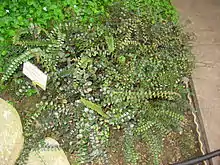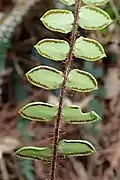Pellaea rotundifolia
Pellaea rotundifolia, the button fern, is a species of fern endemic to New Zealand, where it grows in scrub and forests.[2] It is also a popular garden plant (in zones 8 and 9) and house plant, tolerating low temperatures but not freezing.[3]
| Pellaea rotundifolia | |
|---|---|
 | |
| Scientific classification | |
| Kingdom: | Plantae |
| Clade: | Tracheophytes |
| Class: | Polypodiopsida |
| Order: | Polypodiales |
| Family: | Pteridaceae |
| Genus: | Pellaea |
| Species: | P. rotundifolia |
| Binomial name | |
| Pellaea rotundifolia (G. Forst.) Hook. | |
| Synonyms[1] | |
| |
Pellaea rotundifolia is a compact, evergreen fern that can have more than 30 pairs of round, dark-green, leathery pinnae on fronds up to 18 in (460 mm) in length.[2] The Latin specific epithet rotundifolia means “round-leaved”.[4]
 Underside of the pinnae
Underside of the pinnae In cultivation
In cultivation
Cultivation
It needs acidic and well-drained soil; it does not appreciate the moist, humid conditions that most ferns require so does well with minimal watering.[2]
This plant has gained the Royal Horticultural Society’s Award of Garden Merit.[3][5]
References
- Hassler, Michael & Schmitt, Bernd (November 2019). "Pellaea rotundifolium [sic]". Checklist of Ferns and Lycophytes of the World. 8.11. Retrieved 2019-01-05.
- Olsen, Sue. Encyclopedia of Garden Ferns. 2007.
- "RHS Plantfinder - Pellaea rotundifolia". Retrieved 18 April 2018.
- Harrison, Lorraine (2012). RHS Latin for Gardeners. United Kingdom: Mitchell Beazley. ISBN 978-1845337315.
- "AGM Plants - Ornamental" (PDF). Royal Horticultural Society. July 2017. p. 75. Retrieved 21 April 2018.
- Sp. fil. 2:136. 1858.
- G. Brownlie, "Cyto-Taxonomic Studies on New Zealand Pteridaceae", New Phytologist, Vol. 56, No. 2 (Jul., 1957), pp. 207–209.
- Gerald J. Gastony and David R. Rollo, "Phylogeny and Generic Circumscriptions of Cheilanthoid Ferns (Pteridaceae: Cheilanthoideae) Inferred from rbcL Nucleotide Sequences", American Fern Journal, Vol. 85, No. 4, Use of Molecular Data in Evolutionary Studies of Pteridophytes (Oct. - Dec., 1995), pp. 341–360.
- Nico Vermeulen, Encyclopedia of House Plants, Taylor & Francis, 1999, pages 22–23. ISBN 978-1-57958-108-4.
This article is issued from Wikipedia. The text is licensed under Creative Commons - Attribution - Sharealike. Additional terms may apply for the media files.